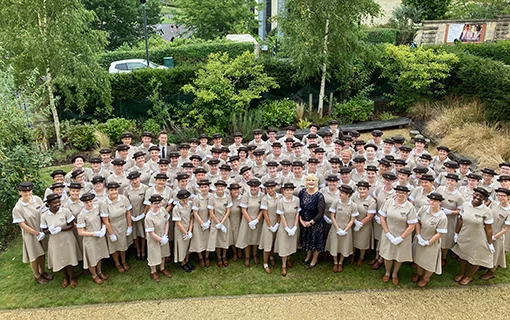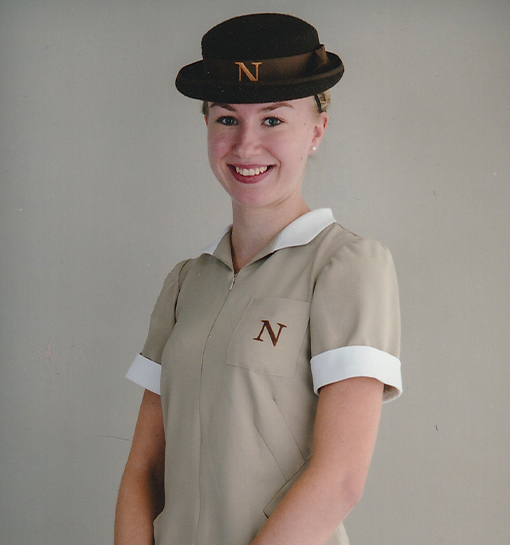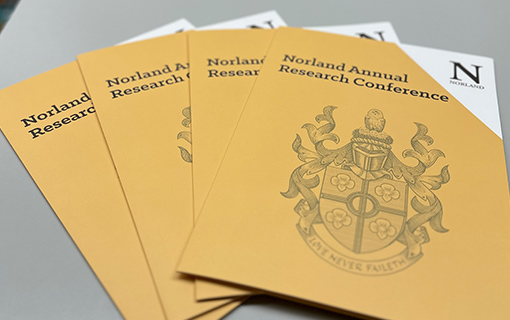The history of Norland in 13 objects: the first Norlander speedwell badge
15 September 2022

The fourth object in our series celebrating Norland’s 130-year history is one of the earliest Norlander badges. First awarded in 1902, the badge remains an integral part of Norland’s heritage, recognising the professional career of the Norland nursery nurse and introducing its twin mottoes and the speedwell flower emblem that are still a feature of Norland’s badges today.
On the afternoon of Monday 16 June 1902, the nursery nurses of the Norland Institute lined up in their uniforms to receive the first Norland badges at London’s Steinway Hall.
The Norland Quarterly of June to September 1902 – a quarterly newsletter established by founder Emily Ward to ensure nurses were kept regularly informed of Institute news – detailed the ceremonial proceedings. Emily Ward wrote: “All these nurses were arrayed in strict Norland uniform, viz., the easily recognised cornflower blue dress, insertion apron, and brown summer bonnet, and all looked spotless.”
In total, 45 nurses received the first Norland badges. Most of these, 41, attended the ceremony in person to receive their badges directly from honoured guest Lady Dudley in front of employers, fellow nurses, friends, and supporters of the Norland Institute.
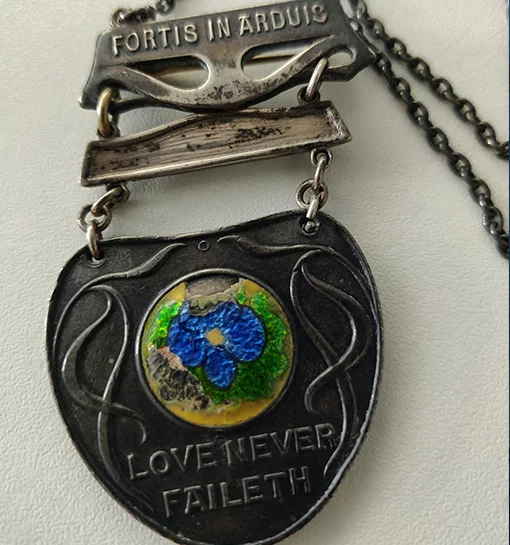
Fortunately, one of the very first badges awarded at the 1902 ceremony is housed in Norland’s archives. It belonged to Nurse Kate Fox, who trained at Norland from 1894 until 1895, in recognition of her employment service. The silver art nouveau badge features an enamel speedwell flower, a little damaged through wear in what was a long and distinguished career as a Norland nurse. On the front are the twin Norland mottoes ‘Love Never Faileth’ and ‘Fortis In Arduis’ (translated as ‘Strength in Adversity’). Engraved on the back, below Norland Institute, are the words: “Award of highest merit to Kate Fox for not less than 5 years faithful work – 3 being under one employer 1895 to 1902”.
Nurse Fox enjoyed a varied and extensive career. She was employed after completing her training by Empress Frederic of Germany to care for her daughter the Crown Princess of Greece in the nursery of the King’s palace in Athens, where her charges were later to include the Princess Marina of Greece and Denmark and her two sisters Princess Olga and Elizabeth, cousins to Prince Phillip, the Duke of Edinburgh. The photograph shows Nurse Fox with Princess Marina (centre), Princess Olga (left) and Princess Elizabeth (right). At the outbreak of the First World War, Nurse Fox returned to England and took up a post in the Norland Nurseries. When she retired, Nurse Fox moved to live near Princess Marina, then the Duchess of Kent.
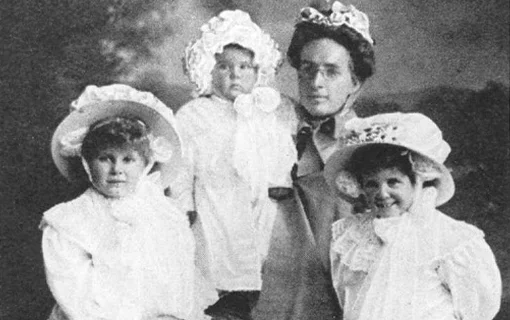
The introduction of the Norland long-service badge reflected a growing need to recognise the professional career achievements of the Institute’s graduates, to distinguish Norland nurses when not in uniform, and as a mark of quality. Its inauguration brings with it the formalisation of a career path for its graduates and lifelong connection with the Institute.
In the December 1897 issue of the Quarterly, Principal Isabel Sharman first introduced the badge idea in response to calls from nurses asking how they might be recognised as Norland Nurses when not in uniform. She writes “We are fully alive to the advantage of Private Nurses being able to recognise one another, and the importance of their holding some guarantee that not only has their connection with the Institute not been severed, but that is it stronger than ever.”
She added: “We are going to do something, but have not yet quite decided what it is to be, and so are open to suggestions. We shall, in all probability, have a badge to be worn in some conspicuous place.”
The criteria for earning the Norland badge were set out as “a fresh honour”, further to having achieved the Norland certificate and private nurse status. The provisional plans outlined that badges would be awarded to nurses that had worked five years since qualifying including one position of no less than three years, secured satisfactory employer testimonials, kept their dress “neat, quiet and suitable to the work of a lady nurse”, and maintained a close connection to the Institute through at least three visits during the five years.
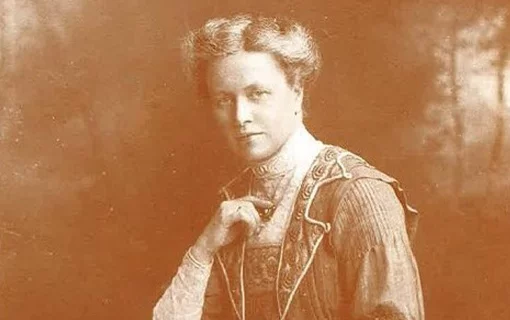
Reflecting Norland’s pioneering history in establishing the new profession of the trained nursery nurse, the early career path of the Norland nurse was detailed alongside the badge design and criteria.
First, the training period, during which time they would be known as a probationer, followed by three years in employment as a nurse strictly subject to the rules of the Institute. Then as a private nurse, to some extent independent of the Institute, before they re-joined the Institute having satisfied the requirements of the badge and the benefits associated with it. Throughout this time, graduates must also have met the Institute’s exacting standards; longevity of career and loyalty to one family was not enough. Once a nurse received her badge, she would “rejoin the Institute”, and be entitled to a pension, and earnings of £40 or more per year.
Given that the average annual salary in the 1901 census was £42.70, and that accommodation, food and other living costs were also provided, this guaranteed minimum salary indicates that Norlanders were earning well from the start. The Norland Agency, then known as the Registry, was established early on both as an employment agency and as a guiding influence on working conditions. Recommended salaries were firmly laid down, and comparisons were made with the earnings of other trained professionals such as governesses and teachers. Norlanders continue to earn well today, with average salaries available through the Norland Agency well above typical earnings in the early years sector and comparable only to medical and economics graduates.
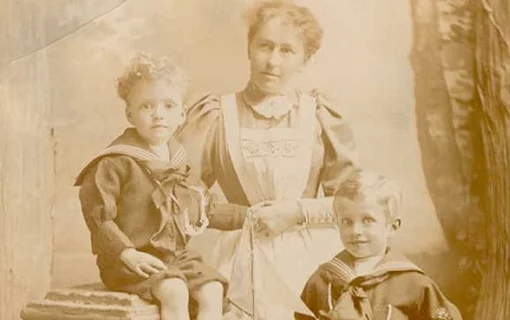
The choice of imagery and motto to adorn the badge was an important consideration for the Norland community.
In 1897, the design idea proposed was “that it should take the form of a medal, on the obverse showing a representation of Christ with a child in His arms, as an example of our love of, and work amongst, children; and a border of some spring flowers denoting youth”. On the reverse side, it was suggested that the name of the institute, the nurse and the date she gained the certificate be engraved.
Norlanders were encouraged to respond to the proposal, share their ideas and vote. Nurses with significant work experience were invited to attend the spring 1898 “At Home” event to discuss the badge. These events were held quarterly and served as nurse reunions. First held in August 1897, they featured prominent speakers including Ramsay MacDonald and Mrs Winston Churchill.
A series of letters from nurses were published in subsequent Quarterlies, indicating their enthusiasm for the badge as a symbol of career recognition. The holder of our first badge, Nurse Fox, commended the idea. She wrote: “I was very glad to find by the last Quarterly that others agreed with me as to the desirability of a distinguishing badge”.
Isabel Sharman provided an update on the design in the June 1899 Quarterly. She explained that the ribbon badge idea had been rejected as “too perishable”, and that the badge would “take the form of a medal that may be worn on the watch chain or adapted as a brooch”. She listed some suggested mottoes, and asked nurses to vote for their favourite by postcard. The suggestions ranged from the aspirational “Aim high” and “Dare! Strive! Hope!” to the religious “See God in everything” to the humble “With both hands earnestly”. While there were several centred on love, the mottoes eventually chosen to adorn the badge were not among the options.
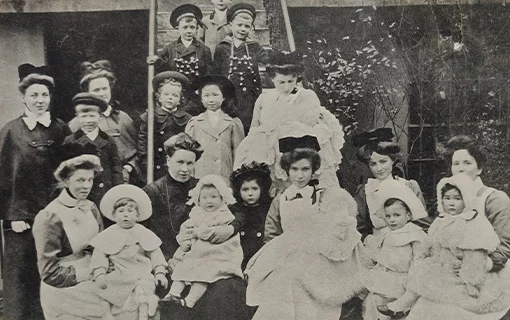
“Apart from its intrinsic value, which is considerable, the inscription on the back will be one of which we shall all justly be proud, and the medal should remain an heirloom in your family.” Emily Ward, March 1902, Norland Quarterly.
In the Quarterly of December 1901, Emily Ward noted the “deep importance” of the badge which is “not to be carried out without much consideration, because once made we must stick to it.” She pledged that she and Isabel Sharman would “take some definite and final steps on the subject by next March”. In the March 1902 issue, Emily Ward reported their progress and the twin Norland mottoes first appeared. No explanation was given as to how these were arrived at. One imagines they were the fruit of ongoing discussions and ponderings by Emily Ward and Isabel Sharman while finalising the badge design between January and March 1902.
The specification for the badge drawn up by Emily Ward requested that it be made of silver and enamel with a flower or dove design, and not to exceed £1 in price. She stipulated that the motto ‘Love Never Faileth’ should appear on the front – giving it seniority – and ‘Fortis in Arduis’ on the front or back. The decorative design was left with the artist, guided by suggestions of “a flower, as lily, daisy, Speedwell, or a dove, something symbolical of childhood, or suggestive, like the Speedwell, or a border 1 of perforation of flowers, denoting gentleness.” Emily Ward also specified the need for the badge not to have “points or a scratchy surface that could hurt children” and that it should be “solid, nothing pliable or frail”. Three firms competed for the order by submitting their designs for selection. Emily Ward confirmed they had chosen the one “that will give the most general satisfaction”.
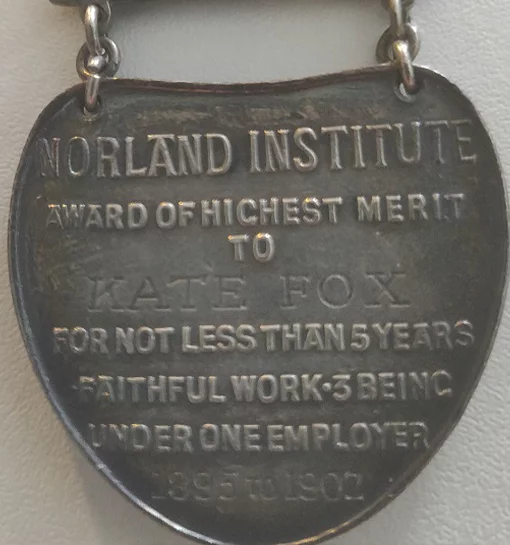
The speedwell badges and their awarding ceremonies were a great success, popular with nurses and their employers. The second badge ceremony was held in 1905. The badge ceremonies became important reunions for the nurses of the Norland Institute.
In 1911, long-service bars were introduced. Badge nurses who had completed 10 years in one post received a silver bar, 15 years earned a blue enamel bar and 20 years was recognised with a green bar.
In the October 1978 Quarterly, an article on the history of Norland noted that by “1928 of the 1,087 trained nurses, 81 had earned badges for long service in one situation, eleven for over 25 years with one family.”
Over the years, as it became more typical for nurses to work with several families during their career rather than the tradition of lifetime service, the badge was updated to reflect the modern career path of the professional nursery nurse. In 1962, the long-service badge and bar system was replaced with the coveted silver speedwell badge that is still awarded to all fully qualified Norlanders today.
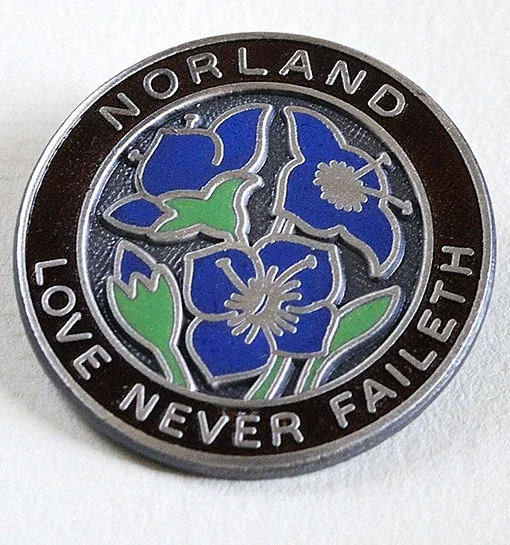
The badge mottoes and emblems introduced in 1902 remain central to Norland’s culture and ethos. In its 130th anniversary year in 2022, Norland awarded its own degrees for the first time since being granted taught degree awarding powers in 2019. A new coat of arms featuring the speedwell flower and motto ‘Love Never Faileth’ was unveiled to mark the occasion alongside a newly designed graduation gown that included the blue of the speedwell.
The speedwell badge is a tangible reminder of Norland’s pioneering history and continued innovation at the forefront of early years training and higher education.

